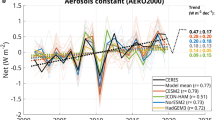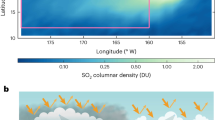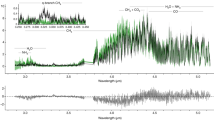Abstract
Variations in the Sun's total energy output (luminosity) are caused by changing dark (sunspot) and bright structures on the solar disk during the 11-year sunspot cycle. The variations measured from spacecraft since 1978 are too small to have contributed appreciably to accelerated global warming over the past 30 years. In this Review, we show that detailed analysis of these small output variations has greatly advanced our understanding of solar luminosity change, and this new understanding indicates that brightening of the Sun is unlikely to have had a significant influence on global warming since the seventeenth century. Additional climate forcing by changes in the Sun's output of ultraviolet light, and of magnetized plasmas, cannot be ruled out. The suggested mechanisms are, however, too complex to evaluate meaningfully at present.
This is a preview of subscription content, access via your institution
Access options
Subscribe to this journal
Receive 51 print issues and online access
$199.00 per year
only $3.90 per issue
Buy this article
- Purchase on Springer Link
- Instant access to full article PDF
Prices may be subject to local taxes which are calculated during checkout





Similar content being viewed by others
References
Wigley, T. M. L. & Raper, S. C. B. Climatic change due to solar irradiance changes. Geophys. Res. Lett. 17, 2169–2172 (1990)
Kasting, J. F. Planetary atmospheres: Warming early Earth and Mars. Science 276, 1213–1215 (1997)
Hays, J. D., Imbrie, J. & Shackleton, N. J. Variations in the Earth's orbit: Pacemaker of the Ice Ages. Science 194, 1121–1132 (1976)
Willson, R. C., Gulkis, S., Janssen, M., Hudson, H. S. & Chapman, G. A. Observations of solar irradiance variability. Science 211, 700–702 (1981)
Fröhlich, C. Solar irradiance variability since 1978: Revision of the PMOD composite during solar cycle 21. Space Sci. Rev. (in the press); preprint at ftp://ftp.pmodwrc.ch/pub/Claus/ISSI_WS2005/ISSI2005a_CF.pdf (2006)
Foukal, P. Solar Astrophysics 2nd edn (Wiley-VCH, Weinheim, 2004)
Foukal, P., Bernasconi, P. & Walton, S. A model of solar irradiance variation using broad band measurements of facular photometric contrast. Astrophys. J. (in the press); preprint at http://sd-www.jhuapl.edu/SBI/Pubs/Foukal_etal_ApJ_Letts_2006.pdf (2006)
Foukal, P. V. & Lean, J. Magnetic modulation of solar luminosity by photospheric activity. Astrophys. J. 328, 347–357 (1988)
Chapman, G. A., Cookson, A. M. & Dobias, J. J. Variations in total solar irradiance during solar cycle 22. J. Geophys. Res. 101, 13541–13548 (1996)
Fröhlich, C. & Lean, J. Solar radiative output and its variability: Evidence and mechanisms. Astron. Astrophys. Rev. 12, 273–320 (2004)
Wenzler, T. Reconstruction of Solar Irradiance Variations in Cycles 21–23 based on Surface Magnetic Fields. PhD thesis, Eidgenössische Technische Hochschule, Zürich (2005)
Wilson, P. R. in Physics of Sunspots (eds Cram, L. & Thomas, J.) 83–97 (Sacramento Peak Observatory, Sunspot, New Mexico, 1982)
Zahid, H. J., Hudson, H. S. & Fröhlich, C. Total solar irradiance variation during rapid sunspot growth. Sol. Phys. 222, 1–15 (2004)
Schatten, K. H., Mayr, H. G., Omidvar, K. & Maier, E. A hillock and cloud model for faculae. Astrophys. J. 311, 460–473 (1986)
Parker, E. N. Theoretical properties of omega-loops in the convective zone of the sun. 2: The origin of enhanced solar irradiance. Astrophys. J. 440, 415–420 (1995)
Schüssler, M. & Vögler, A. Magnetoconvection in a sunspot umbra. Astrophys. J. 641, L73–L76 (2006)
Spruit, H. C. The flow of heat near a starspot. Astron. Astrophys. 108, 356–360 (1982)
Foukal, P., Fowler, L. A. & Livshits, M. A thermal model of sunspot influence on solar luminosity. Astrophys. J. 267, 863–871 (1983)
Spruit, H. C. Heat flow near obstacles in the solar convection zone. Sol. Phys. 55, 3–34 (1977)
Chiang, W. H. & Foukal, P. V. The influence of faculae on sunspot heat blocking. Sol. Phys. 97, 9–20 (1985)
Spruit, H. C. Pressure equilibrium and energy balance of small photospheric fluxtubes. Sol. Phys. 50, 269–295 (1976)
Lites, B. W., Scharmer, G. B., Berger, T. E. & Title, A. M. Three-dimensional structure of the active region photosphere as revealed by high angular resolution. Sol. Phys. 221, 65–84 (2004)
Carlsson, M., Stein, R. F., Nordlund, Å. & Scharmer, G. B. Observational manifestations of solar magnetoconvection: Center-to-limb variation. Astrophys. J. 610, L137–L140, doi:10.1086/423305 (2004)
Fowler, L. A., Foukal, P. V. & Duvall, T. L. Jr Sunspot bright rings and the thermal diffusivity of solar convection. Sol. Phys. 84, 33–44 (1983)
Rast, M. P. et al. Bright rings around sunspots. Nature 401, 678–680 (1999)
Foukal, P. V. & Fowler, L. A. A photometric study of heat flow at the solar photosphere. Astrophys. J. 281, 442–454 (1984)
Spruit, H. in Sun in Time (eds Sonnet, C., Giampapa, M. S. & Matthews, M. S.) 118–158 (Univ. Arizona Press, Tucson, 1991)
Rosenthal, C. S., Christensen-Dalsgaard, J., Nordlund, Å., Stein, R. F. & Trampedach, R. Convective contributions to the frequencies of solar oscillations. Astron. Astrophys. 351, 689–700 (1999)
Petro, L. D., Foukal, P. V. & Kurucz, R. L. Photospheric limb-darkening signatures of global structure variations. Sol. Phys. 98, 23–38 (1985)
Chiang, W.-H., Petro, L. D. & Foukal, P. V. A photometric search for solar giant convection cells. Sol. Phys. 110, 129–138 (1987)
Woodard, M. F. & Libbrecht, K. G. Spatial and temporal variations in the solar brightness. Sol. Phys. 212, 51–64 (2003)
Livingston, W. & Wallace, L. The Sun's immutable basal quiet atmosphere. Sol. Phys. 212, 227–237 (2003)
Antia, H. M. Does the Sun shrink with increasing magnetic activity? Astrophys. J. 590, 567–572 (2003)
Kuhn, J. R., Bush, R. I., Emilio, M. & Scherrer, P. H. On the constancy of the solar diameter II. Astrophys. J. 613, 1241–1252 (2004)
Brown, T. M. & Christensen-Dalsgaard, J. Accurate determination of the solar photospheric radius. Astrophys. J. 500, L195–L199 (1998)
Sofia, S. Global variability of the Sun. Mem. Soc. Astron. Ital. 69, 531–537 (1998)
Sofia, S. Variations of total solar irradiance produced by structural changes of the solar interior. Eos 85, 217–221 (2004)
Egidi, A. et al. High-precision measurements of the solar diameter and oblateness by the Solar Disk Sextant (SDS) Experiment. Sol. Phys. 235, 407–418 (2006)
Gilliland, R. L. Theoretical interpretation of the variability of global solar properties. Adv. Space Res. 8, 151–155 (1988)
Kuhn, J. R., Bush, R. I., Scherrer, P. & Scheick, X. The Sun's shape and brightness. Nature 392, 155–157 (1998)
Goldreich, P., Murray, N., Willette, G. & Kumar, P. Implications of solar p-mode frequency shifts. Astrophys. J. 370, 752–762 (1991)
Libbrecht, K. C. & Woodard, M. F. Solar-cycle effects on solar oscillation frequencies. Nature 345, 779–782 (1990)
Dziembowski, W. A. & Goode, P. R. Sources of oscillation frequency increase with rising solar activity. Astrophys. J. 625, 548–555 (2005)
Spruit, H. C. Origin of the torsional oscillation pattern of solar rotation. Sol. Phys. 213, 1–21 (2003)
Radick, R. R., Lockwood, G. W., Skiff, B. A. & Baliunas, S. L. Patterns of variation among Sun-like stars. Astrophys. J. Suppl. 118, 239–258 (1998)
Lean, J., Beer, J. & Bradley, R. Reconstruction of solar irradiance since 1610: Implications for climate change. Geophys. Res. Lett. 22, 3195–3198 (1995)
Lean, J. L., Wang, Y.-M. & Sheeley, N. R. The effect of increasing solar activity on the Sun's total and open magnetic flux during multiple cycles: Implications for solar forcing of climate. Geophys. Res. Lett. 29, 2224, doi:10.1029/2002GL015880 (2002)
Foukal, P., North, G. & Wigley, T. M. L. A stellar view on solar variations and climate. Science 306, 68–69 (2004)
Foukal, P. & Milano, L. A measurement of the quiet network contribution to solar irradiance variation. Geophys. Res. Lett. 28, 883–886 (2001)
Hoyt, D. V. & Schatten, K. H. A discussion of plausible solar irradiance variations, 1700–1992. J. Geophys. Res. 98, 18895–18906 (1993)
Solanki, S. & Fligge, M. Solar irradiance since 1874 revisited. Geophys. Res. Lett. 25, 341–344 (1998)
Lockwood, M., Stamper, R. & Wild, M. A doubling of the Sun's coronal magnetic field during the past 100 years. Nature 399, 437–439 (1999)
Foukal, P. What determines the relative areas of spots and faculae on Sun-like stars? Astron. Astrophys. 500, 958–965 (1998)
Solanki, S. K., Usoskin, I. G., Kromer, B., Schüssler, M. & Beer, J. Unusual activity of the Sun during recent decades compared to the previous 11,000 years. Nature 431, 1084–1087 (2004)
Muscheler, R., Joos, F., Müller, S. & Snowball, I. Climate: How unusual is today's solar activity? Nature 436, E4–E5 (2005)
Briffa, K. R. et al. Low-frequency temperature variations from a northern tree ring density network. J. Geophys. Res. 106, 2929–2942, doi:10.1029/2000JD900617 (2001)
Crowley, T. J. Causes of climate change over the past 1000 years. Science 289, 270–277 (2000)
Esper, J., Cook, E. R. & Schweingruber, F. H. Low-frequency signals in long tree-ring chronologies for reconstructing past temperature variability. Science 295, 2250–2253 (2002)
Jones, P. D., Osborn, T. J. & Briffa, K. R. The evolution of climate over the last millennium. Science 292, 662–667 (2001)
Mann, M. E., Bradley, R. S. & Hughes, M. K. Northern Hemisphere temperatures during the past millennium: Inferences, uncertainties, and limitations. Geophys. Res. Lett. 26, 759–762 (1999)
Mann, M. E. & Jones, P. D. Global surface temperatures over the past two millennia. Geophys. Res. Lett. 30, 1820, doi:10.1029/2003GL017814 (2003)
Moberg, A., Sonechkin, D., Holmgren, K., Datsenko, N. & Karlén, W. Highly variable Northern Hemisphere temperatures reconstructed from low- and high-resolution proxy data. Nature 433, 613–617 (2005)
Wigley, T. M. L. & Raper, S. C. B. Interpretation of high projections for global-mean warming. Science 293, 451–454 (2001)
Cubasch, U. & Meehl, G. in Climate Change 2001: The Scientific Basis (eds Houghton, J. T. et al.) 525–582 (Cambridge Univ. Press, Cambridge, UK, 2001)
Raper, S. C. B., Gregory, J. M. & Osborn, T. J. Use of an upwelling-diffusion energy balance climate model to simulate and diagnose A/OGCM results. Clim. Dyn. 17, 601–613 (2001)
Wigley, T. M. L., Ammann, C. M., Santer, B. D. & Raper, S. C. B. Effect of climate sensitivity on the response to volcanic forcing. J. Geophys. Res. 110, D09107, doi:10.1029/2004JD005557 (2005)
Harvey, L. D. D. et al. in IPCC Technical Paper 2 1–50 (eds Houghton, J. T. et al.) (Intergovernmental Panel on Climate Change, Geneva, Switzerland, 1997)
Ammann, C. M., Meehl, G. A., Washington, W. M. & Zender, C. S. A monthly and latitudinally varying volcanic forcing dataset in simulations of 20th century climate. Geophys. Res. Lett. 30, 1657, doi:10.1029/2003GL016875 (2003)
Lean, J. Evolution of the Sun's spectral irradiance since the Maunder Minimum. Geophys. Res. Lett. 27, 2425–2428 (2000)
Bard, E., Raisbeck, G. M., Yiou, F. & Jouzel, J. Solar modulation of cosmogenic nuclide production over the last millennium: comparison between 14C and 10Be records. Earth Planet. Sci. Lett. 150, 453–462 (1997)
Fisk, L. A. et al. Global processes that determine cosmic ray modulation. Space Sci. Rev. 83, 179–214 (1998)
Field, C., Schmidt, G., Koch, D. & Salyk, C. Modeling production and climate-related impacts on 10Be concentration in ice cores. J. Geophys. Res. (in the press); preprint at http://pubs.giss.nasa.gov/docs/notyet/2006_inpress_Field_etal.pdf (2006)
Bond, G. et al. Persistent solar influence on North Atlantic climate during the Holocene. Science 294, 2130–2136 (2001)
Hu, F. S. et al. Cyclic variation and solar forcing of Holocene climate in the Alaskan subarctic. Science 301, 1890–1893 (2003)
Shindell, D. T., Schmidt, G. A., Miller, R. L. & Mann, M. E. Volcanic and solar forcing of climate change during the preindustrial era. J. Clim. 16, 4094–4107 (2003)
Harrison, R. G. The global atmospheric electrical circuit and climate. Surv. Geophys. 25, 441–484, doi:10.1007/s10712-004-5439-8 (2004)
Haigh, J. D. The effects of solar variability on the Earth's climate. Phil. Trans. R. Soc. A 361, 95–111 (2003)
Foukal, P. A comparison of variable solar total and ultraviolet irradiance outputs in the 20th century. Geophys. Res. Lett. 29, 2089, doi:10.1029/2002GL015474 (2002)
Acknowledgements
P.F. acknowledges support by NASA; T.M.L.W. was supported by the NOAA Office of Global Programs. TSI research at PMOD/WRC is supported by the Swiss National Science Foundation. Author Contributions Author order is alphabetic. P.F. and H.S. contributed the theory of solar luminosity variation, T.M.L.W. the climate modelling and C.F. the consolidated irradiance measurements.
Author information
Authors and Affiliations
Corresponding author
Ethics declarations
Competing interests
Reprints and permissions information is available at www.nature.com/reprints. The authors declare no competing financial interests.
Rights and permissions
About this article
Cite this article
Foukal, P., Fröhlich, C., Spruit, H. et al. Variations in solar luminosity and their effect on the Earth's climate. Nature 443, 161–166 (2006). https://doi.org/10.1038/nature05072
Issue Date:
DOI: https://doi.org/10.1038/nature05072
This article is cited by
-
A history of solar activity over millennia
Living Reviews in Solar Physics (2023)
-
Plant macrofossils as indicators of vegetation and climate change in the Northern Black Forest of Germany during the last millennium - with focus on the Little Ice Age
Vegetation History and Archaeobotany (2023)
-
Sea surface temperature evolution in the Yellow Sea Warm Current pathway and its teleconnection with high and low latitude forcing during the mid-late Holocene
Journal of Oceanology and Limnology (2022)
-
The Privileged Life of a Theoretical Observer
Solar Physics (2022)
-
The total solar irradiance during the recent solar minimum period measured by SOHO/VIRGO
Scientific Reports (2021)
Comments
By submitting a comment you agree to abide by our Terms and Community Guidelines. If you find something abusive or that does not comply with our terms or guidelines please flag it as inappropriate.



